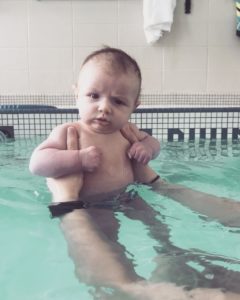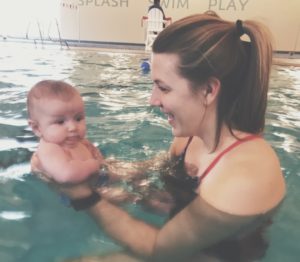
May is National Water Safety Month. While I haven’t personally experienced the horror of losing a child to drowning the topic is near and dear to my heart. Swimming has always been a part of my life in some aspect, whether that was competing, coaching, teaching lessons, or being on the lake for recreation. After I married my swim coaching husband our lives have revolved around swim seasons and our now 18-month-old, Avett, has no choice but to tag along to the pool with us most evenings. Because of my experience and our lifestyle that keeps us close to the water, we started Avett with “lessons” at 2 months old and I want you to know that your child can start that early as well!

Formal swim lessons are so important, but the largest mistake that I see parents make is waiting until age 3 or 4 to start these and waiting that long to expose their children to water at all. Drowning is one of the leading causes of death in children under the age of 4 and yet, this seems to be the average age for beginning any type of water exposure.
I understand that lessons can be pricy. They’re just not in the budget for a lot of families. And if the price isn’t a contributor, sometimes parents who are unfamiliar with water themselves are just less likely to introduce their children to any type of swimming experience at a young age. I believe that this contributes to high rates of children drowning because water is so foreign to a lot of children, and their parents. I know someone personally whose young family member drown in front of a group of adults who were unable to save her, none of the adults knew how to swim.
It’s tragic and heartbreaking to me, so I want to share several ways that you can begin introducing your children to water at little to no cost, sometimes even in your own home.
Water familiarity can begin anywhere
Even a cheap inflatable pool and especially your bathtub at home can be used. Encourage your child to lie on their back, get their ears in the water, float on their front, put their face in, and blow bubbles. As soon as children can identify facial features tell them to put their nose, ears, eyes, etc. into the water. A lot of kids will be scared to put their face in the water at first. Unfortunately, this is the key to swimming. In order to be able to float on top of the water, you have to be able to get your face wet! At 18 months Avett can identify several facial features so most nights in the bathtub we practice. He puts his nose, each of his ears, and his whole face into the water and blows bubbles. When we can get to the pool, these skills transfer!
Lose the lifejacket/puddle jumper
A lot of children are comfortable in the water…with a lifejacket or a puddle jumper on. These are great tools to use, especially at a lake, but when you are able to give your child some one-on-one attention at the pool, take these off! I’ve taught so many kids who have no concept of what their body weighs in water. They are so used to having a float on that they aren’t prepared for the strength that it will take to keep their head above water without any type of assistance.
Take a step back
Without any type of flotation assistance, practice having your child jump into the water holding on to your hands. Gradually allow them to stay under the water for longer periods of time before pulling them to the surface, let them learn how long to hold their breath, and what body movements it will take to help them get to the surface. Gradually back off until your child is comfortable jumping to you. Stand close so you can help, but allow them to come to the surface on their own. If a child is too scared or too young to jump off the wall start by sitting them on the wall and holding their hands.
Make it fun! And always monitor your child
Be a great example! Put your face in the water, bob under the water and blow bubbles so your child will see that it’s safe for them to try too! Swimming is hard work. If your child seems to be getting tired, take a break or stop all together for the day.

For all ages, make sure to stress the importance of having an adult present before even stepping a toe in the water. Review safety reminders each time you are near water. It’s hard to guarantee safety around water, I know that. But early exposure and building familiarity is important when it comes to keeping children, and adults safe. Introducing your child to water doesn’t have to be complicated and it can start at a very early age in the comfort of your own home!
We also have several local resources here in Indy, these are just a few!
Stoney Creek Swim Center offers FREE lessons for babies 4 weeks-6 months. It’s a bit of a drive south side friends, but those first months are at no cost!
Our Indy YMCA offers many lesson options for infants on up. Scholarships and discounted rates are available.
Indy Infant Swimming resource also offers several Indy locations for lessons.








